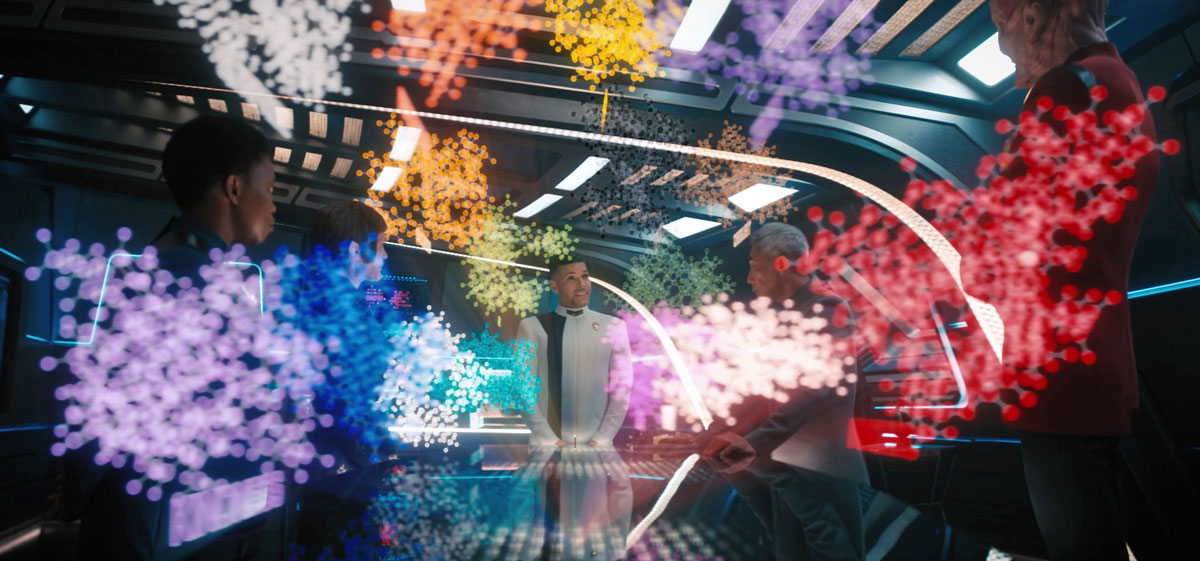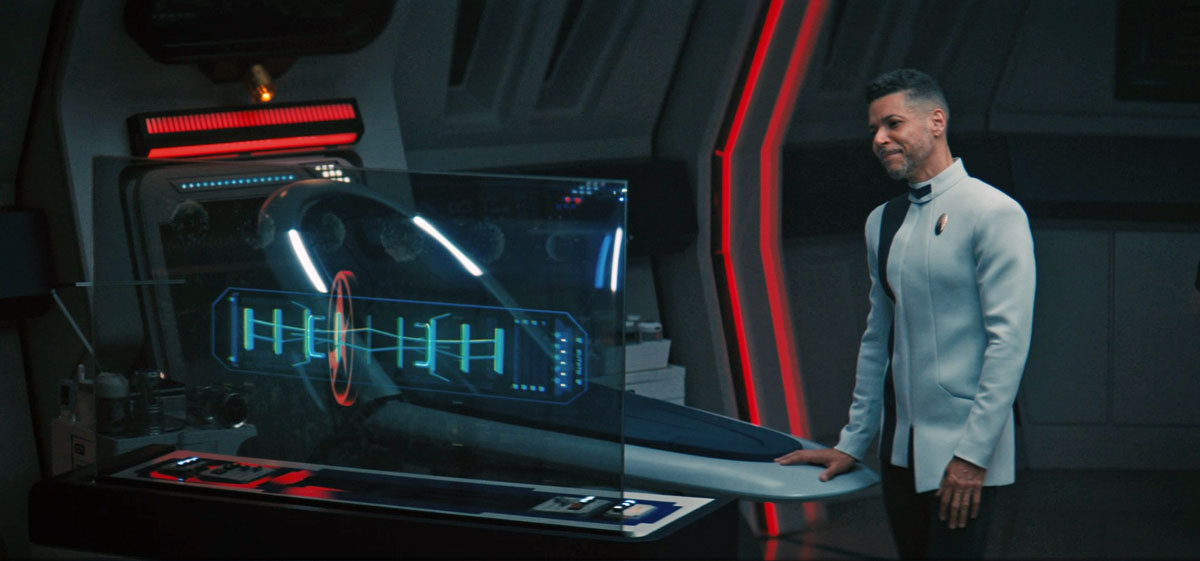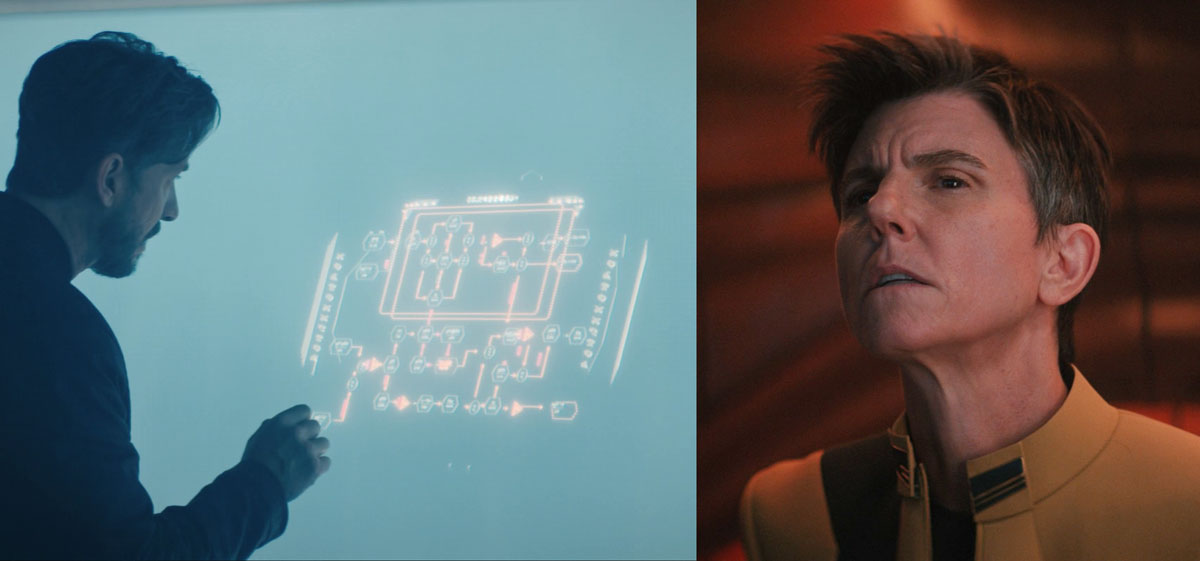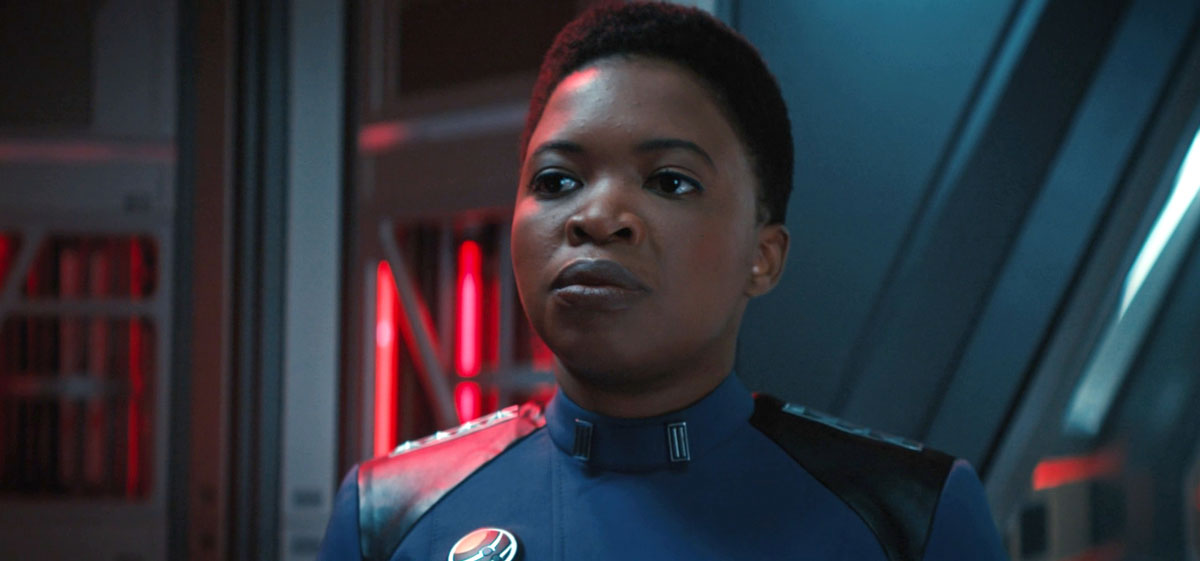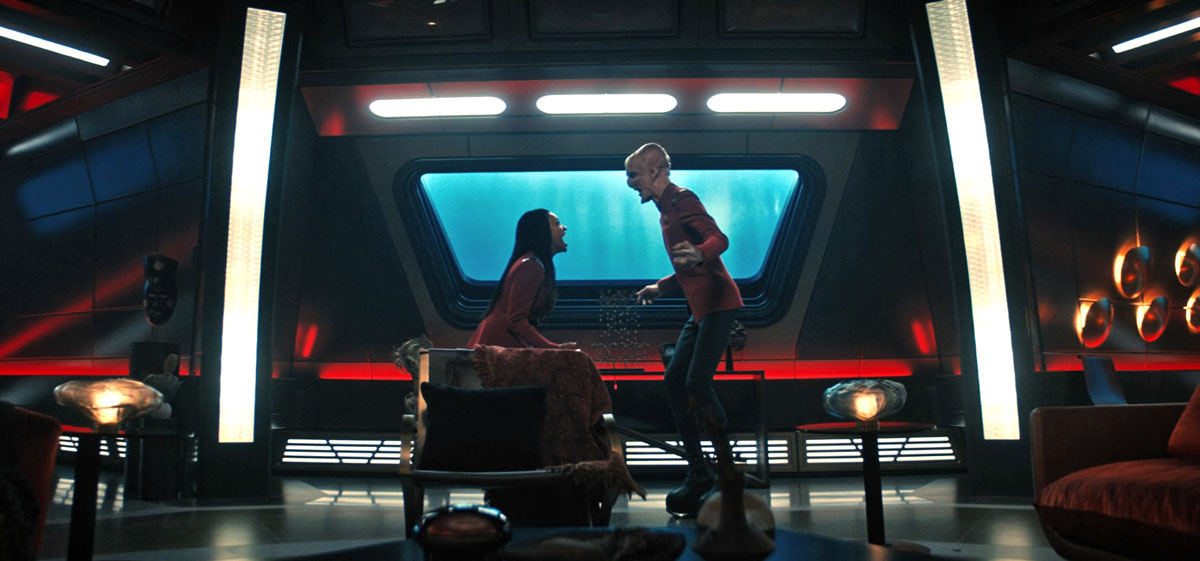Star Trek: Discovery’s depiction of first contact successfully delivers on the promise of truly alien aliens, and — following in the footsteps of films like Contact, Arrival, and The Abyss — “Species Ten-C” creates an intriguing and truly original communication scenario between 10-C and Discovery. That the B-story elements don’t necessarily keep pace is a bit of a let down, but not enough to detract from what the A-story does so well.
The episode opens with a jarring time jump after the closing events of last week’s “Rosetta,” the audience catching just the tail end of Discovery’s first attempt at first contact — and the decision to move on to the team’s Plan B. The scene is so abrupt, and skips past so much of the analysis and discussion about the hydrocarbons that had been set up in “Rosetta,” that I checked the episode number to make sure I hadn’t accidentally skipped a week. It’s the right episode, it just feels like there’s a scene or two missing.
(This is yet another head-scratcher about the pacing of this season; once I had my bearings on where in the story we were, thought, the entire puzzle of if and how communication with 10-C would even be possible had my rapt attention.)
The aforementioned Plan B, which is sending a group of DOTs out to the hyperfield to spray it with “peaceful” hydrocarbons, succeeds a little too well as Discovery is quickly sucked up by what can really only be described as the “Russian water tentacle” from The Abyss. Species 10-C remains cautious even after bringing the ship into the hyperfield, however, and keeps Discovery encased in a ball of, well, something that holds it in place and neutralizes the ship’s defensive systems.
Eventually, Species 10-C makes direct contact and the delegation heads down to the cargo bay to stand face-to-face with the enormous alien floating off the stern. The alien emits a complex pheromone that translates roughly to “cautious, but intrigued,” and displays a pattern of flashing bioluminescence that is assumed at first to be the bulk of the message.
It must be, right? Because language has semantic structure and the light has a pattern. Well, not quite. It turns out that the pheromones themselves — both the molecular structure and their emotional meaning — are the message and the light pattern provides the order in which the molecule should be “read,” and that precise meaning and emotional inflection exist simultaneously.
While the solution to this puzzle is reached a little too easily, it’s impressive that the writers approached the communication challenge with such nuance and consideration.
Mentions of METI (a counterpart to SETI that’s concerned with sending messaging out to any extraterrestrial intelligence that might be listening, whereas SETI searches for messages sent to us), the hypothetical Kardashev Scale (which categorizes a civilization’s level of technological advancement), and examples of human communication systems such as music that contain both emotional abstraction and mathematical precision show that the writers have given careful thought to just how difficult communication with an entirely unknown entity would be.
It’s an intellectually rewarding solution to one of the season’s primary mysteries, and one that is satisfying enough to excuse the lengthy journey to get here even if it’s still not fully justified.
Meanwhile — and in unfortunate contrast to how good the linguistic A-story is — Zora (Annabelle Wallace) informs Stamets (Anthony Rapp) with frustrating vagueness that she is feeling “off,” and requests help in identifying what exactly she’s experiencing. With the help of Culber (Wilson Cruz) and the return of Gray’s Trill meditation game, she eventually leads him and Adira (Blu del Barrio) to Engineering where they discover the source of Zora’s strange sensations — and also that Reno has disappeared.
Of course, we know from the start that what Zora is sensing is the result of Tarka’s system patch, and that it’s important that she find and remove it. That said, it’s still asking a lot of us to believe that the characters would drop everything during the most important few hours of their lives to give Zora a therapy session.
One of the great enduring lessons of Star Trek is that everyone’s experiences and instincts are important and worth hearing out, but even so the timing and presentation of this was difficult to take seriously. And as with other similar storylines this season, it relies too much on the audience’s external knowledge to accept the internal actions of the characters.
And speaking of Jett Reno (Tig Notaro), she remains captive aboard the tagalong ship, listening in as Book (David Ajala) and Tarka (Shawn Doyle) openly discuss their plans as if Reno isn’t sitting, you know, right there. (I know Book’s ship isn’t very large so there isn’t really anywhere to put Reno, but we also know that forcefields can be set up to at least block sound, so…)
At one point Tarka pulls up a flow diagram of what should theoretically happen when he pulls the DMA’s power source and Reno is alarmed by what she sees — and I’m alarmed that Microsoft Visio appears to still be alive and well in the 32nd century!
It becomes evident to Reno that not only will pulling the power source collapse the hyperfield, destroying everyone inside it, it will also leave an enormous sector-wide subspace rift in the DMA’s wake… a rift that will destroy Earth and Ni’Var just as completely as the DMA itself. That the rift will travel slowly enough to provide a month of evacuation time is hardly a comfort.
Aboard Discovery and after a few more back-and-forths between the delegates and 10-C in which the two groups establish a basic communication system, 10-C sends a pod over in a (likely) invitation to continue communicating. Captain Burnham (Sonequa Martin-Green), Saru (Doug Jones), Ni’Var’s president T’Rina (Tara Rosling), and Federation president Rillak (Chelah Horsdal) take part in the venture, while Earth’s General Ndoye (Phumzile Sitole) declines to join the rest of the group out of distrust.
While I understand that Ndoye’s perspective is a product of Earth’s current isolationist stance, I so wanted her to put her skepticism aside and give first contact with 10-C more of a chance. Being frustrated that the first attempt doesn’t immediately work, but also not wanting to try something else seems like setting yourself up for failure and denying the opportunity for any other outcome than one of disappointment.
It’s difficult as a viewer, because I like Ndoye and wanted to think that she could become a better version of herself, but at the same time the consistency of her stance seems recognizably realistic. Star Trek can at times be a bit heavy-handed with its real-world analogues, but at least in this respect Captain Ndoye seems like someone we could all know.
Back aboard Book’s ship, Reno quietly shares her concerns about Tarka’s plan with the Kwejian. She’s been whittling away at him for a while trying to get him to see the folly of continuing with his vendetta — even sharing a moving story of her own experiences with grief after the death of her wife and the crash of the Hiawatha — but it’s the revelation that Tarka’s plan is as destructive as the DMA itself that finally gets his attention.
The news that Tarka has been deceiving Book isn’t particularly surprising, nor is the fact that, once Book does confront him, Tarka has some tech trickery up his sleeve that renders him literally untouchable.
After his fruitless attempts to physically stop Tarka, Book is locked in the makeshift brig with Reno. On Discovery, Ndoye continues to feed info to Tarka and eventually even goes so far as to use her override code on the ship’s systems so Tarka can escape. She really doesn’t trust 10-C. (Why the leader of a non-Federation world would have override codes for a Starfleet ship is beyond me.)
Just as communication between the diplomatic team and 10-C progresses to the point that it’s possible to express that the is harmful — and it’s possible that 10-C understands them — things go sideways. Tarka puts his plan into DMA action, punching through the strange barrier that’s been holding both ships in an act that certainly seems like aggression; 10-C immediately ceases communication efforts and retreats away from Discovery.
With a timely message from Reno explaining Tarka’s plan and the horrible consequences should he succeed, Discovery is left with a madman to pursue and an all-powerful alien species to placate — and not a lot of time to do it.
OBSERVATION LOUNGE
- If anyone is interested in learning more about the linguistic and anthropological challenges of communicating with an entirely unknown species, NASA and SETI published an excellent book on the topic called Archaeology, Anthropology, and Interstellar Communications, which is available on the NASA website as a free download.
- Since this is an episode about cross-species communication, it seems appropriate to air some grievances about the bizarre choice of cat noises that are dubbed in for Grudge. The low yowling sound that they often have her making is a territorial warning sound made between two cats who are about an inch away from fighting, not one that a calm solitary cat would ever make, and the fact that she keeps making it has me worried about her stress level. Is Grudge okay?
- Jeno disassembles a tricombadge, allowing us to see the inner construction for the first time.
- We’ve known for a while that Cleveland Booker isn’t Book’s birth name, but in “Species Ten-C” we finally learn the story behind it: he’s the fifth in a line of couriers to be given the name, passed from generation to generation between mentors and mentees. I wonder who the original Cleveland Booker was and what his story is.
- Twice in this episode, Burnham and Saru stop to have little asides to discuss what seem like frivolous topics in the middle of a serious, intellectually taxing situation. The first time Saru asks for relationship advice, and the second Burnham confides that she’s feeling insecure and the whole thing culminates with the two of them doing yelling exercises.
Discovery has always been tonally and thematically interested in exploring the emotions of its characters, but given their context, these scenes felt like a stretch… even for this show.
If not for Tig Notaro — who is always a breath of fresh air but gives an especially good performance here — the portion of the episode dedicated to Tarka’s intrigue would be frustrating in that it takes runtime away from the much more interesting A-story. Even Tarka, who I genuinely liked longer than I probably should have after learning that yes he is the bad guy, is starting to feel one-note.
There is one person though who might be able to get through to Species 10-C, and he just happens to be on his way to the DMA’s power source: Book. With his empathic abilities that work across vastly different species of plant, animal, and person, I suspect Book will be key to all of this.
With just one more episode left in the season, for the first time we can say with certainty that we won’t have to wait to find out.
![]()
Star Trek: Discovery closes out its fourth season on March 17 on Paramount+ in the United States, and on CTV Sci Fi Channel and Crave in Canada. Outside of North America, the series is available on Paramount+ and on Pluto TV in select international locations.

